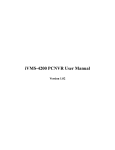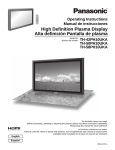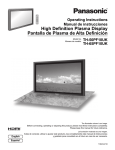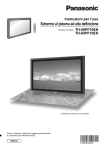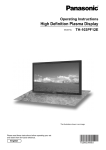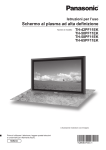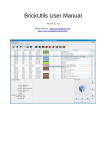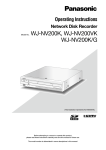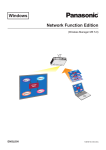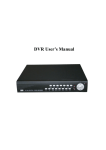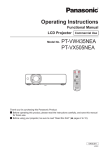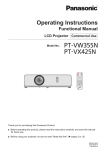Download Wireless Presentation Board
Transcript
Operating Instructions Wireless Presentation Board Model No. reless TY-FB10WPU Card Before connecting, operating or adjusting this product, please read these instructions completely. Please keep this manual for future reference. English TQZH824-2 Contents FCC STATEMENT ....................................................... 3 Safety Precautions (Be sure to observe) ................ 3 Handling Cautions ..................................................... 3 Before using wireless card ....................................... 3 Accessories ............................................................... 4 Software Licensing Agreement ................................ 5 Notes on Using Wireless Connection...................... 6 Parts and their functions .......................................... 8 Installing and removing the wireless card/Installing and removing the unit to the display .................................... 9 Check your computer ............................................. 10 Software Installation ............................................... 11 Installation free set up ............................................ 13 Software Uninstall ................................................... 13 Making Connections ............................................... 14 Useful Functions ..................................................... 34 Selective area transmission ………………………………… Secondary display transmission …………………………… One shot function ……………………………………………… Shutter function ………………………………………………… Pointer function ………………………………………………… Functions used with each display method ………………… Setting options ........................................................ 38 Setting option window ………………………………………… 38 Using WebBrowser.................................................. 41 Computer settings ……………………………………………… 41 Accessing from the Web browser …………………………… 41 Description of Each Screen ………………………………… 42 Other Connection Methods .................................... 51 Connecting through the access point ……………………… 51 When logging on without administrator authority ……… 51 Returning to the Initial Settings ............................. 53 Glossary ................................................................... 54 Frequently Asked Questions .................................. 56 Trademarks .............................................................. 60 Connections …………………………………………………… 14 Connection error messages ………………………………… 17 Other operations for connection............................ 19 Cancelling the connection …………………………………… Operations when password entry is required for connection…………………………………………………… Adding and deleting connections …………………………… Searching by unit’s ID ………………………………………… 19 20 20 21 Various display methods ........................................ 22 Description of the launcher…………………………………… Live mode………………………………………………………… Multi live mode ………………………………………………… Multiple Source Live Mode …………………………………… Multiple Source Multi Live Mode …………………………… 34 35 36 36 36 37 22 24 25 30 32 Please note the following. • Panasonic cannot be held liable for any direct or indirect damages resulting from the use or malfunction of this unit. • Panasonic cannot be held liable for damages arising from data corruption or loss as a result of using this unit. 2 FCC STATEMENT FCC STATEMENT This equipment has been tested and found to comply with the limits for a Class B digital device, pursuant to part 15 of the FCC Rules. These limits are designed to provide reasonable protection against harmful interference when the equipment is operated in a commercial environment. This equipment generates, uses, and can radiate radio frequency energy and, if not installed and used in accordance with the instruction manual, may cause harmful interference to radio communications. Operation of this equipment in a residential area is likely to cause harmful interference in which case the user will be required to correct the interference at his own expense. FCC CAUTION: Pursuant to 47CFR, Part 15.21 of the FCC rules, any changes or modifications to this monitor not expressly approved by Panasonic Corporation of North America could cause harmful interference and would void the user’s authority to operate this device. Safety Precautions (Be sure to observe) WARNING • Never attempt to disassemble or modify this product. To avoid fire, shock or failure. • If you sense smoke, an odd odor, or unusual noises while in operation, immediately unplug the display. Switch off the display and unplug the power cord plug from the supply outlet. To avoid fire or shock, do not leave the power of the display turned on. • To avoid shock or other problems, do not leave the power cord plug plugged into the supply outlet. • Please contact our designated service department for installation or change of this product. • To Service personnel: Before removing or installing the Terminal Board, be sure to turn power of the display off and unplug the power cord plug from the supply outlet. Handling Cautions • Do not touch connector contacts with hands directly. To avoid electrostatic damage to internal parts, before handling this product touch a large metallic object such as a steel cabinet to discharge yourself. • Be sure to use the supplied cable or specified parts for interconnection. To avoid malfunction or failure, do not use parts other than those recommended. Before using wireless card Concerning the card slot Do not insert foreign objects into the card slot. Inserting the card with a foreign object inside may cause damage on the card. 3 Accessories • Remote control [N2QAFB000004] ON • Terminal function label (1 sheet) OFF INPUT ASPECT ENTER INDEX RETURN MENU ID SET ID ALL (Affix this label to applicable slot of the rear panel of the display.) VOL • Remote control batteries (AA Battery x 2) • CD-ROM disc (Wireless Manager ME. etc) [TVD01013] • Wireless card protection cover • Wireless card [N5HZZ0000042] • Screw × 4 (Slot cover cramping screw) • Screw × 2 (Screws for cramping wireless card protection cover) FCC : MXF-S941212G IC : 3069B-WSDB101G Slot Nos. of the display unit that are compatible with terminal board attachments. 2 slot model 3 slot model SLOT1 + SLOT2 SLOT1 + SLOT2 or SLOT2 + SLOT3 * Settings must be made for the display unit. (See page 9) 4 Software Licensing Agreement Use of this Software is governed by the terms defined in this Software Licensing Agreement. Article 1 License Licensee is granted the right to use this software, including the information recorded or described on the CD-ROM and in the instruction manual and any other media provided to the Licensee (collectively “Software”), but all applicable rights to copyright or intellectual property in the Software are not transferable to the Licensee. Article 2 Use by a Third Party Licensee may not transfer or allow any third party, to use or copy the Software, whether free of charge or not. Article 3 Restrictions on Copying the Software Licensee may make a single copy of the Software in whole or in part solely for backup purposes. However this excludes those copied using this software. Article 4 Computer Licensee may install and use the Software on more than one computer owned or managed by Licensee. However, such use is restricted to only applications involving the unit. Article 5 Reverse Engineering, Decompiling or Disassembly Licensee may not reverse engineer, decompile or disassemble the Software. Panasonic shall not be bound by warranty for any defects in the Software caused by Licensee’s reverse engineering, decompiling or disassembly of the Software. Furthermore, Panasonic or its distributors or dealers will not be responsible for any damage to the Licensee caused by Licensee’s reverse engineering, decompiling or disassembly of the Software. Article 6 After-sales Service If a problem should occur with the Software while Licensee is using the Software, Licensee should notify Panasonic of the problem by telephone or letter. Panasonic shall undertake to notify Licensee of whether the problem is a known error in the program (“bug”), or whether the way in which the Software is to be used should be modified. Furthermore, the Software is subject to revision without prior notice. Article 7 Indemnification Panasonic’s liability with respect to this Software is limited to the conditions defined in Article 6 herein. Panasonic or any of its distributors or dealers shall not be liable for any damage suffered by Licensee, either directly or through claims from a third party, arising from or in connection with Licensee’s use of the Software. Furthermore, Panasonic makes absolutely no warranty for the use of this Software for any purpose other than for applications associated with the unit with which this Software is bundled. Article 8 Export Control Licensee agrees not to export or re-export the Software to any county other than the country of purchase of the unit in any form without the appropriate export licenses under the regulations of the country where Licensee resides or of any other country as may be required by such export or re-export. Wireless Manager uses the following software: Portion of this software are based in part on the work of the Independent JPEG Group 5 Notes on Using Wireless Connection Wireless equipment that has obtained a certificate of conformity is supplied with this unit. Wireless connection function of the unit uses radio waves in the 2.4 GHz band. A radio station license is not required, but be sure to read and fully understand the following items before use. Do not use near other wireless equipment. The following equipment may use radio waves in the same band as the unit. When the unit is used near these devices, radio wave interference may make communication impossible, or the communication speed may become slower. • Microwave ovens, etc. • Industrial, chemical and medical equipment, etc. • In-plant radio stations for identifying moving objects such as those used in factory manufacturing lines, etc. • Designated low-power radio stations If at all possible, avoid the use of cellular phones, TV sets or radios near the unit Cellular phones, TV sets, radios and similar devices use different radio bands from the unit so there is no effect on wireless communication or the transmission and reception of these devices. However, radio waves from the unit may produce audio or video noise. Wireless communication radio waves cannot penetrate steel reinforcements, metal, concrete, etc. Communication is possible through walls and floors made from materials such as wood and glass (except glass containing wire mesh), but not through walls and floors made from steel reinforcements, metal, concrete, etc. Using the unit outside the country It is forbidden to take the unit outside the country or region where you purchased it, so use it only in the said country or region. Also, note that depending on countries or regions there are restrictions on the channels and frequencies at which you can use the wireless LAN. Security Notes This device uses radio waves to establish a wireless connection between the PC and display. Although this device employs security measures, this security is not perfect due to the properties of radio waves. Check the points below to ensure maximum security. • When multiple devices are installed, if you select the wrong connection in the Select Connection screen, the data can be revealed to a third party. Be sure to check that the connection is correct. • This device has the security measures (WEP. WPA) described above. The possibility of security problems occurring is reduced by making security settings. 6 Notes on Using Wireless Connection (cont.) Channels that can be used The channels (frequency range) that can be used differ according to the country or region. Refer to the table below. Country or region Standard Japan ARIB STD-T66 England, Germany, France, Spain, Italy, Belgium, Austria, Sweden, Norway, Denmark, Switzerland, Holland, Finland, Portugal, Greece ETSI 300.328 Singapore IDA Australia, New Zealand C-Tick Malaysia SIRIM United States FCC part 15 Canada IC RSS-210 Taiwan DGT Channels used Frequency band (Center frequency) 1 - 13 2,412 MHz 2,472 MHz 1 - 11 2,412 MHz 2,462 MHz Remote Control Battery Installation 1 Open the cover. 2 Insert batteries and close the cover. Note the correct polarity (+ and -). Precautions Mishandling of batteries can cause electrolyte leakage which can damage items the fluid contacts and may cause a fire. • Do not mix old and new batteries. • Do not use different types at the same time. (ex. zinc carbon and alkaline) • Do not burn or breakup batteries. Batteries must not be exposed to excessive heat such as sunshine, fire or the like. • Do not take apart or short circuit. • Do not attempt to recharge, short-circuit, disassemble, heat or burn used alkaline or manganese batteries. • Replace the batteries if the remote control does not work properly. For your reference Use alkaline batteries for longer life. 7 Parts and their functions Remote control POWER ON button Input selector button Select the setting suitable for the connected device. Function in the same way as the INPUT button on the remote control for the display. (Refer to the instructions for the display.) Screen mode button Function in the same way as the ASPECT button on the remote control for the display. (Refer to the instructions for the display.) Up and Down buttons This key can be used to control PC applications which support it. POWER OFF button ON OFF INPUT ASPECT Enter button Set the screen when Multi-live Mode (Index Style) is selected. ENTER INDEX RETURN MENU Left and right buttons Select the screen when Multi-live Mode (Index Style) is selected. Return button No operation can be made to the unit. ID SET ID ALL VOL Menu button No operation can be made to the unit. Index button Switch the display screen (Multilive Mode) Volume buttons Increase or reduce volume. ID setting button (ID SET) Set the ID of the remote control when operating a system that uses a multiple number of displays. ID setting button (ID ALL) Establish a mode for the simultaneous control using a single remote control when operating a system that uses a multiple number of displays. Numbered buttons Set the remote control ID. While holding down the ID SET button, input a 2-digit ID by pressing the corresponding number keys. Wireless card ヂ Connector The port where the wireless card is connected to the wireless card slot on the display. Do not touch it. 2 ッ Wireless card access monitor light Flashes when wireless communication is opened. 1 8 Installing and removing the wireless card/Installing and removing the unit to the display 1 Insert the wireless card into the unit. 2 Install the wireless card protection cover with the two screws (Push it until a click is heard.) ※When removing the card, push it until a click is heard and then remove it. Wireless card protection cover 3 Install the unit into the slot of the display. See Slot Nos. of the display unit that are compatible with terminal board attachments. (Page 4). Foam mat or thick soft cloth To install 2. Insert the terminal board until 3. Affix the terminal function label it is firmly plugged into the (included). connector. Tighten screws in the order 1 - 4. 1. Remove the slot cover. To remove Remove the slot cover. Grip the handle of the terminal board, and slowly pull out in the direction of the arrow. Securing screw T1 SLOT1 SLOT2 SLOT2 SLOT3 SLOT3 4 SLOT1 SLOT2 SLOT3 3 SLOT2 PC IN SER 2 1 SLOT3 • Make sure that the Board does not ride on the two lower claws. • Be sure to fasten all screws tightly. • Have the customer keep the removed Terminal Board for future servicing needs. Set the display unit according to the slot being used. (a) Press the [SET UP] button on the remote control for the display unit to display the menu screen. (b) Press the up/down buttons to move the cursor and select “OSD Language”. (c) Press the [SURROUND] button for three or more seconds to display the “Options” menu. (d) Press the up/down buttons to move the cursor and select the item “Serial Slot Select” on page 3. (e) Press the left/right buttons to move the cursor and select the setting that corresponds to the slots being used. When installing in SLOT1+SLOT2: Set to “SLOT1” When installing in SLOT2+SLOT3: Set to “SLOT2” 9 Check your computer Necessary environment for computers to be connected • First, check your computer to see whether or not it has a built-in wireless LAN* function. *LAN : “Glossary” (See page 54) • Before connecting the unit to the computer, be sure to check the following settings. • Operation is not guaranteed for all wireless cards and built-in wireless LAN adapters. Check 1 Wireless LAN settings <Computer with a built-in wireless LAN function> • Is your wireless LAN switched on? <Computer without a built-in wireless LAN function> • Is your wireless LAN card properly recognized? • Is the wireless LAN card switched on? • Install the wireless LAN card driver beforehand. For details on how to install the driver, refer to the instructions accompanying the wireless card. • Refer to the following URL for the types of wireless LAN cards that system operation capabilities are confirmed. http://panasonic.co.jp/pavc/global/projector/ Check 2 Logon user’s settings • Have you logged in as the Administrator? Check 3 Computer’s settings • When security (firewall) software and utilities for network cards are installed, these may prevent connection of the unit. <Windows XP> • Is Network Bridge enabled? • Has your firewall been disabled? 10 Software Installation System requirements The computer must meet the following requirements in order to use the supplied software. OS: CPU: Microsoft Windows 2000 Professional/XP Home Edition/XP Professional Intel® Pentium® III 600 MHz or faster, or compatible processor (800 MHz or faster is recommended when using live mode) RAM: 256 MB or more Empty hard disk capacity: 60 MB or more Hardware conditions: CD or DVD drive (for software installation and viewing the user’s manual) LAN terminal (10BASE-T/100BASE-TX/1000BASE-T) An 802.11 b/g built-in wireless LAN system or an 802.11 b/g wireless LAN adapter must be installed and running properly. However, some 802.11 b/g wireless LAN may not allow connection to 802.11 g units. Web browser: Internet Explorer 6.0 or newer Netscape Communicator 7.0 or newer Note Note that operation is not guaranteed when used with system environments other than the above or on homemade computers. Operation is not guaranteed for all computers that meet the above conditions. This software performs wireless LAN transmission using the image data in the OS. Therefore, note that it may not operate properly when used together with other software (image rotation tools, etc.) that use similar image data. Note This manual uses a computer with the Windows XP (Home Edition) operating system as an example in its explanations. The illustrations and screenshots in this manual may be different from those on your computer. 11 Software Installation (cont.) Contents on Provided CD-ROM When inserting the provided CD-ROM into the computer, the installer starts up automatically and the following screen appears. Notes • Shut down all software currently active on Windows. Otherwise, installation may not be possible. • Administrator authority is required for installation. • If the installer does not start up automatically, double-click [EasyInstall] → [Easy_Inst.exe] in the CD-ROM. • If Wireless Manager ME 1.0 / 2.0 / 3.0 has been installed, uninstall it by following the instructions on the screen. • The Wireless Manager is used to send screen displays and audio from the computer to this unit. Although the Wireless Manager supports both wireless LAN and wired LAN connections, the unit only supports a wireless LAN connection. Wireless Manager ME 4.0 This software is used to send screen images from a computer to the unit via a wireless LAN. 1 Click [Wireless Manager ME 4.0]. Follow the instructions on the screen and install the software. 12 Installation free set up You can use Wireless Manager ME 4.0 without installing it in the computer. If you copy Wireless Manager ME 4.0 to a removable medium, such as an SD card, you can use Wireless Manager ME 4.0 without installing it in any computer that permits you to access this removal medium. Note When copying Wireless Manager ME 4.0 to a removable medium, empty capacity of at least 32 MB is required. 1 2 3 Insert provided CD-ROM into the CD-ROM drive. Setup screen appears. Click [Installation Free Set Up]. [Direct CD-ROM Startup] and [Other Media Source Startup, Make Copy Here] appear on the window. A When using without copying the program: Click [Direct CD-ROM Startup]. Wireless Manager ME 4.0 starts up, and the “Select Access Port” window appears. Operation is the same as when operating after installing CD-ROM. (See page 14) B When using after copying the program: Click [Other Media Source Startup, Make Copy Here]. A window opens to select the destination to save. <If you chose B in step 3, follow steps 4-5.> 4 Select the destination to save, and click [OK]. 5 Double-click the Wireless Manager ME 4.0 icon (WM.exe) in the destination to save chosen in step 4. CD-ROM data is copied to the destination. After the copy ends, click [Close] of the setup screen. Wireless Manager ME 4.0 starts up. Operation is the same as when operating after installing CD-ROM. If selecting removable medium as the destination to save, ensure that the removable medium is recognized by the computer to which you wish to connect the unit. Some removable mediums start the program automatically. Notes • When using without installing, following functions are not available. • Selective area transmission (See page 34) • Secondary display transmission (See page 35) • Producing audio along with video at live mode • Automatic connection by double-clicking (see page 40) • Operation is slower compared to when the computer is used with Wireless Manager ME 4.0 installed. Software Uninstall Wireless Manager ME 4.0 From the desktop, select [Start] → [All Programs] → [Panasonic Wireless Display] → [Uninstall Wireless Manager mobile edition 4.0]. Follow the instructions appearing on the screen and uninstall the software. 13 Making Connections Notes • Although there are two possible connections methods using either “Simple” settings or “Detailed” settings, only “Detailed” settings can be used with this unit. Be sure to make connections as described below. • Only wireless LAN can be used to connect to this unit. • “Simple” settings are for use with projectors that use the same software and do not function with this unit. Connections 1 Click [ ] on the desktop, or select [Start] → [All Programs] → [Panasonic Wireless Display] → [Wireless Manager mobile edition 4.0]. When the [Input User Name] window appears Set the icon and user name, and click [OK]. When the confirmation dialog box appears Click [Yes]. When the [Network Adapter Selection] window appears ヂ Select the Wireless LAN. ッ Select the adapter from the list and click [OK]. If the confirmation dialog box appears, click [Yes]. Notes • Enter the user name in up to 8 alphanumerics. • The icon and user name are set when Wireless Manager ME 4.0 is first launched. • The icon and user name settings can be changed in the “Option” window (See page 38) 14 Making Connections (cont.) 2 Click [Detailed]. The units that can be connected are displayed on the “Select Access Port” window. ヅ ヂ テ ッ デ ツ ト ド ナ ニ ヌ ネ ヂ Network When you specify the network number (See page 44) set on the unit from one of [1], [2], [3], [4], and [U (USER)]※1, units that are presently switched on in the selected network number are displayed in [Projector Name]. The initial value for both the computer and the unit is [1]※2. ※1-2 (See page 16) ッ ID (See page 21) Display unit’s ID ツ Mode (See page 24) Display unit’s mode or style ヅ Access Devices When only one unit is connected, select [ ]. When multiple units are connected, select [ ]. テ Available mode and functions Among [Live mode], [Multi live mode], [One shot], unavailable one is displayed with [ ]. デ The number of people connected to this unit ト The status of this unit ド [ ] appears when password entry is needed for connection. (See page 20) ナ Connection message Blinks when connection is not possible. Click to display information on resolving the issue. (See page 17) ニ Connectability When you click “Connectability” the unit name and ID are displayed in the upper left of the display to which the selected unit is connected. If the unit name and ID are displayed correctly, the message “Projector is available.” will appear on the computer screen. ヌ Designate (See page 20) Designate units to be connected when ヂ is set to [U]. ネ ID Search (See page 21) When you click [ID Search], a search for the unit of the specified ID is carried out from among the units that are presently switched on, from all channels other than [U]. 15 Making Connections (cont.) 3 In [Network], select the network number set for the unit. • Units powered on in the chosen network group are listed. • This value is set to [1] by default. • For details on setting a network number for the unit, see page 44. Note If the selected unit does not appear some time after this operation, select the network number again, and check the selection status. 4 Select the desired units, and click [OK]. The launcher appears and the connection with the unit is established. (“Description of the launcher” →See page 22) Note The launcher is not output on the display. Notes • Easy wireless connection cannot be made between the unit and the computer. (See page 56) • Automatic connection setting (See page 40) ※1 • In the following situations, connections other than [U] are not possible. - Not logged in with Administrator rights - When using Windows Vista • Depending on the computer and wireless LAN card used, easy wireless set up may not be possible. If this is the case, the [Network] setting of “Select Access Port” window will be switched to [U] automatically. For details of the connection procedure, first close Wireless Manager ME 4.0, and then refer to pages 51-52. ※2 • The initial network number for both the unit and Wireless Manager ME 4.0 is [1]. These numbers must match for the connection. To check the network number, check under WEB browser control. (See page 44). • When importance is placed on security, select the network number [2]-[4], because WEP* (wireless communication encryption) is set on these network numbers. • Important video/audio data is protected because AES* encryption processing takes place in advance for all network numbers, even if [ENCRYPTION] is set to [NONE]. • Other network adapters may not be usable under easy wireless set up connections. • Connections to other networks connected through the wireless LAN card are broken under easy wireless set up connections. * “Glossary” (See page 55) 16 Making Connections (cont.) Connection error messages When wireless LAN connection cannot be established, [ Click the [ ] blinks in the bottom left of the “Select Access Port” window. ] button at this time to display information on resolving the issue as shown below. The displayed information is as follows. Detected issue A firewall or network bridge is detected Displayed information [****]※ is installed. When destination cannot be identified, deactivate [****] which is the cause. Remarks Reference page • Has your firewall in Windows XP been disabled? • Is Wireless Manager ME 4.0 registered in [Exceptions] ([Control Panel] → [Security Center] → P.56 - P.57 [Windows firewall]) with the Windows XP SP 2? • Are any firewall-containing applications installed? • If you do not expect ever to use Network Bridge and see no need for it, delete it from your system. ※ “Windows Firewall”, “Network Bridge” and other security software found will appear in [****] 17 Making Connections (cont.) Detected issue Displayed information Remarks When a change in the settings made by the utility has been detected The settings of Wireless Network connection have been changed. When a Wireless LAN Card utility or any other utilities are active, stop the operation of such utilities, then restart the application. The wireless LAN utility used by the computer may have changed the wireless settings. Close the utility, and then make the connection again using easy wireless set up connection. When a setting error for the wireless LAN card has been detected No response from the wireless LAN card. Check the followings: - Wireless LAN Card conditions - Driver version (Latest) • Is the wireless LAN card effective? • Is your wireless LAN card properly recognized? • Some wireless cards may allow easy wireless set up connections to function if drivers are updated. When the user does not have the administrator authority Please execute “Easy Connection” using the administrator authorization mode. If you have logged onto a computer as a [GUEST] or a restricted user who does not have administrator authority, you can not perform easy wireless set up (Network No. [1] – [4]). If you must perform wireless set up without administrator authority, designate [U] as the network number. 18 Reference page − P.56 P.51 Other operations for connection Canceling the connection 1 Click [ ] on the launcher. The following window appears. When connecting the unit for the first time The “Preservation of a Profile” window appears. Set the save destination and file name, and click [OK]. If you do not need to create a profile, click [Close]. 2 Click [Yes]. The computer returns to the original network settings when the connection is ended. However, note that some time may be needed to return to the original network settings. Click [No] to return to the launcher. Note When the launcher is minimized, right click [ ] on the notification area to display pop up menu and click [End]. 19 Other operations for connection (cont.) Operations when password entry is required for connection When a unit with the [ ] mark is selected, the window shown to the right appears. Enter the password and click [OK]. (See page 48) Notes • Click [CANCEL] at the password entry window to return to launcher (See page 22). • When an incorrect password is entered, an error message appears. Click [OK] to return to the password entry window and enter the correct password again. Adding and deleting connections When [Network] is set to [U] and the desired unit is not displayed at the “Select Access Port” window, connections can be added and deleted by the following operations. Adding a connection 1 Click [Designate] at the “Select Access Port” window. 2 Click [ADD] and enter the IP address* (including its periods) of the connection to be added, and then click [REGISTER]. The window shown to the right appears. * “Glossary” (See page 54) The newly registered connection is added to the connection list in the window shown in step 1. Deleting a connection Select the connection to be deleted at the window shown in step 1 and click [DELETE]. 20 Other operations for connection (cont.) Searching by unit’s ID Even if there are two or more units with the same name, an ID ([Disp] + 4-digit number) is assigned to each unit to enable the units to be identified. When you click [ID Search], a search for the unit of the specified ID is carried out from among the units that are presently switched on, from all channels other than [U]. It is necessary to know ID in advance. If you write down the ID displayed on the “Select Access Port” window in advance, you can search a unit by the ID from next time. 1 Click [ 2 Click [ID Search]. 3 Enter four figures of desired unit’s ID (Enter only a 4-digit number), and click [Search]. ] on the launcher. The window shown to the right appears. The window shown to the right appears. Start Searching. 4 When the unit of the applicable ID is found, the computer will be connected to that unit, and the status display of the launcher will turn green. If appropriate ID is not found, an error message appears. 21 Various display methods Description of the launcher The launcher always appears on the computer screen, and can be used to perform various operations. • By default, the “simple launcher” is displayed. Select the launcher using the Simple Launcher <> Full Launcher select button. The display mode that the system was in when Wireless Manager ME 4.0 was exited is activated the next time the program is started. • Two launcher button sizes are allowed, the [Small button] and the [Large button]. This is controlled in [Launcher size setting] in “Option” window. (See page 40) Simple launcher Full launcher Place in notification area To the full launcher Cancel connection ヂ ッ Mute Volume control ※ Right-click [ ] on the notification area to display the menu. To the simple launcher ヂ ッ Status indication ヂ Communication environment: Displays the strength of the connection. ッ Status : Indicate the connecting status. Connected units’ names, IDs, and their status are displayed in the pop up window when the cursor is on [ ] of the launcher. When connected to one unit (Green, lit):Transmission possible (Blue, blinking):Own computer currently transmitting (When in live mode) (Yellow, lit):Other user currently transmitting (Red, lit):Communication impossible (Black, lit):When the unit has not been selected When connected to multiple units (Green, lit):All transmission possible (Blue, blinking):Currently transmitting (Yellow, blinking):Communication impossible for more than one unit (Red, lit):All communication impossible (Black, lit):When the unit has not been selected 22 Sendable Projector Name : [ ID ] :Status Name2207 : [Disp2207] :OK Various display methods (cont.) Full launcher ツ ヅ テ デ ト ド ナ ニ ヌ ネ ノ ツ Live Mode: Displays the computer screen over the entire display screen. (See page 24) ヅ Select Access Port: Displays the “Select Access Port” window. (See page 15) テ Virtual remote control: Does not function on this unit. デ Multi Live Mode: Display the screens of multiple computers on the divided display screen. In 16-screen index style, [ ] changes to [ ]. (See page 25) ト Selective area transmission: By using the selective area window, you can specify the necessary information alone from the computer screen, and display it on the display screen. (See page 34) ド Secondary display transmission: You can set the computer screen and the display screen to which the unit is connected to multi-monitor mode and use the computer screen as the primary monitor and the display screen as the secondary monitor. (See page 35) ナ One Shot function: The screen displayed when you click the mouse is display as a still image. (See page 36) ニ Shutter function: Momentarily blanks the screen and mutes audio. (See page 36) ヌ WEB control: Allows display controls and settings to be made using the PC computer’s WEB browser. (See page 41) ネ Option: Displays the “Option” window. (See page 38) ノ Pointer function: You can change the shape of the pointer appearing on the display screen. (See page 36) 23 Various display methods (cont.) Live mode Connect a computer to a unit, and display the computer screen over the entire display screen. 1 Press the [INDEX] button on the remote control to turn the display screen into a full screen display (the status when no index window is displayed). If you press the [INDEX] button once or twice when index windows are displayed on the display screen, the screen will switch over to a full screen display. 2 Check the status indication on the launcher to make sure that transmission is possible (check that the green lamp is lit). 3 Click [ ] on the launcher. The current computer screen is transmitted to the selected unit. In the live mode the unit is occupied by a single computer, so operations from other computers are not possible. Clicking [ ] on the launcher allows you to make various picture quality and live mode settings on the “Option” window. Notes • For presentations in live mode, the [▲▼] buttons on the remote control will function in the same way as the computer’s Page Up and Page Down keys. (When using “Presenter View” of “PowerPoint”, the [▲▼] buttons of the remote control correspond to Back space key and Space key.) This means that if you run a computer application that supports the Page Up and Page Down keys, the presentation screen can be changed using the remote control. • Some portions of images are not displayed under some applications (MS Office Assistant, IME Bar, animation and locus of the mouse cursor, and others). • If the connection error occurs during image output, the message ‘Stop “Live mode”’ will appear, then restart live by clicking launcher buttons. • When the computer resolution is higher than XGA, images are converted to XGA size while maintaining the aspect ratio, and then sent. For this reason, black areas may be displayed at the top and bottom or the right and left of the display screen. Quitting live mode Click [ ] on the launcher again. 24 Various display methods (cont.) Multi live mode Switching from one style to another Multi live mode has “4-screen multi style”, “4-screen index style” and “16-screen index style”. Styles are switched by the remote control. How to operate Press the [INDEX] button of the remote control to change the style. • 4-screen multi style Assign an area of one quarter of the display screen to each of up to four computers, and output images on the display screen. [INDEX] button [INDEX] button • 4-screen index style Display the indexes (small screens) of up to four computer screens, and make one of these screens an enlarged display. You can also temporarily switch over to a full screen display. [INDEX] button • 16-screen index style Display the indexes of up to 16 computer screens. You can also temporarily switch over one of these screens to a full screen display. Notes • When the unit starts up, it resumes in the current style the last time the unit was turned off. • When transferring to the live mode, first select the 4-screen multi style, and then click [ ] on the computer. • If you switch over to a 4-screen multi style when five or more computers are connected in a 16-screen index style, the connections to the fifth and higher numbered computers will be nullified. 25 Various display methods (cont.) 4-screen multi style Connect up to four computers to one display, and then divide the display screen into four parts, and simultaneously display the screens for the four computers on the display screen. 1 Press the [INDEX] button on the remote control to turn the display screen into a full screen display (the status when no index window is displayed). (See page 25) If you press the [INDEX] button once or twice when index windows are displayed on the display screen, the screen will switch over to a full screen display. 2 Check the status indication on the launcher to make sure that transmission is possible (check that the green lamp is lit). 3 Click [ ] on the launcher. The window shown to the right appears. 4 Select and click the display position. The computer image is transmitted to the selected quarter of the display screen. Switching to a different position Select and click a different display position in step 4 above. Enlarged display If [ ] is clicked with a computer, display screens temporarily change to full screen display. To return to the original display, click [ ] with the computer that click [ ] and select original positions with each computer. Quitting 4-screen multi style Select and click the checked position in step 4 above. Notes • In the 4-screen multi style, the computer screens from all the computers connected to the unit can be transmitted to the unit. (If an image from another computer has been sent to the image position where an image is already displayed, the existing image is replaced by the new image.) • If the connection error occurs during image output, the message ‘Stop “Live mode”’ will appear, then restart live by clicking launcher buttons. • Clicking [ ] on the launcher allows you to make various picture quality and live mode settings on the “Option” window. 26 Various display methods (cont.) 4-screen index style When the display is set to “4-screen index style”, connect up to four computers to one unit, and then simultaneously display the screens for the four computers on the index windows and also on a large screen. 1 Press the [INDEX] button of the remote control to switch the display screen to “4screen index style”. (See page 25) 2 Check the status indication on the launcher to make sure that transmission is possible (check that the green lamp is lit). 3 Click [ ] on the launcher. The window shown to the right appears. 4 Select and click the display position. The computer image is transmitted to the area of corresponding window. 27 Various display methods (cont.) Enlarged display • Use the [ ] buttons on the remote control to move the focus (yellow box) to the image to be enlarged, and press the [ENTER] button. The image is enlarged and displayed at the top of the display screen. • The image display will fill the entire screen if the [ENTER] button is pressed again. • To return to the 4-screen index style, press the [ENTER] button again. Notes • While an enlarged image is displayed, the [▲▼] buttons on the remote control will function in the same way as the computer’s Page Up and Page Down keys. (When using “Presenter View” of “PowerPoint”, the [▲▼] buttons of the remote control correspond to Back space key and Space key.) This means that if you run a computer application that supports the Page Up and Page Down keys, the presentation screen can be changed using the remote control. • Clicking [ ] on the launcher allows you to make various picture quality and live mode settings on the “Option” window. • If the connection error occurs during image output, the message ‘Stop “Live mode”’ will appear, then restart live by clicking launcher buttons. Quitting 4-screen index style Select and click the checked position in step 4 on the previous page. Note In the 4-screen index style, the green status display lamp remains lit. Other computers can send images only to the windows which are not being used. 28 Various display methods (cont.) 16-screen index style When the display is set to “16-screen index style”, connect up to 16 computers to one unit, and simultaneously display the screens for the 16 computers on index windows and also on a large screen. 1 2 3 Press the [INDEX] button of the remote control to switch the display screen to “16screen index style”. (See page 25) Check the status indication on the launcher to make sure that transmission is possible (check that the green lamp is lit). Click [ ] on the launcher. The computer images are automatically sent to the empty windows on the 16-screen display. Display position is not selectable. Enlarged display • Use the [ ▲▼] buttons on the remote control to move the focus (yellow box) to the image to be enlarged and press [ENTER] to expand that image to fill the display. • Press [ENTER] again to return to the 16-screen index style. Toggle between these with the [ENTER] button. Notes • While an enlarged image is displayed, the [▲▼] buttons on the remote control will function in the same way as the computer’s Page Up and Page Down keys. (When using “Presenter View” of “PowerPoint”, the [▲▼] buttons of the remote control correspond to Back space key and Space key.) This means that if you run a computer application that supports the Page Up and Page Down keys, the presentation screen can be changed using the remote control. • Clicking [ ] on the launcher allows you to make various picture quality and live mode settings on the “Option” window. • If the connection error occurs during image output, the message ‘Stop “Live mode”’ will appear, then restart live by clicking launcher buttons. Quitting 16-screen index style Click [ ] on the launcher again. 29 Various display methods (cont.) Multiple Source Live Mode You can simultaneously display one computer’s screen on up to eight units. 1 Press the [INDEX] button on the remote control to turn the display screen into a full screen display (the status when no index window is displayed). If you press the [INDEX] button once or twice when index windows are displayed on the display screen, the screen will switch over to a full screen display. 2 Click [ ] of the launcher. The “Select Access Port” window appears. 3 Click [ 4 Select the network number of the desired units from [Network]. 5 Select the desired units, and click [OK]. ] of [Access Device]. Units powered on in the chosen network group are listed. Selected units are displayed in pink. If click again, selected items are canceled. If click [OK], the connection with the units is established. 30 Various display methods (cont.) 6 Check the status indication on the launcher to make sure that transmission is possible (check that the green lamp is lit). 7 Click [ ] on the launcher. The displays selected in step 5 will begin displaying. Notes • Units in the same network are selectable. • When one of the selected units is communicating with another computer, or its display screen is not set to full screen display, the images are displayed onto the other selected units. • The greater the number of units, the slower the transmission. • Clicking [ ] on the launcher allows you to make various picture quality and live mode settings on the “Option” window. • Sound cannot be output in the multiple source live mode. • If the connection error occurs during image output, the message ‘Stop “Live mode”’ will appear, then restart live by clicking launcher buttons. Quitting multiple source live mode Click [ ] on the launcher again. 31 Various display methods (cont.) Multiple Source Multi Live Mode Connect up to four computers to each of up to eight units, and display in each unit by the 4-screen multi style. 1 Press the [INDEX] button on the remote control to turn the display screen into a full screen display (the status when no index window is displayed). If you press the [INDEX] button once or twice when index windows are displayed on the display screen, the screen will switch over to a full screen display. 2 Click [ ] of the launcher. The “Select Access Port” window appears. 3 Click [ 4 Select the network number of the desired units from [Network]. 5 Select the desired units, and click [OK]. 6 7 Check the status indication on the launcher to make sure that transmission is possible (check that the green lamp is lit). ] of [Access Device]. Units powered on in the chosen network group are listed. Selected units are displayed in pink. If click again, selected items are canceled. If click [OK], the connection with the units is established. Click [ ] on the launcher. The window shown to the right appears. 32 Various display methods (cont.) 8 Select and click the display position. The computer image is transmitted to the selected quarter of the display screen. Switching to a different position Select and click a different display position in step 8 above. Enlarged display If [ ] is clicked with a computer, display screens temporarily change to full screen display. To return to the original display, click [ ] with the computer that click [ ] and select original display positions with each computer. Secondary viewer function If another computer enlarged the display, your screen is out of the display screen and displayed in the secondary viewer on your computer. (See page 35) Quitting multiple source multi live mode Select and click the checked position in step 8 above. Notes • Units only in the same network are selectable. • If a display whose screen is not set to full screen display is included among the selected displays, [ ] will be grayed out, preventing the display from being selected. • The greater the number of units, the slower the transmission. • In multiple source multi live mode even when the remote control [INDEX] button is pressed no operation will result. • Clicking [ ] on the launcher allows you to make various picture quality and live mode settings on the “Option” window. • If the connection error occurs during display, the message ‘Stop “Live mode”’ will appear, then restart display by clicking launcher buttons. 33 Useful Functions Selective area transmission By using the selective area window, you can specify the necessary information alone from the computer screen, and display it on the display screen. 1 Click [ 2 Surround the desired part to be sent to the display with the selective area window. ] on the launcher. Selective area window (green) appears on computer screen. You can perform operations in the selective area window with the same operation for moving or changing the window on the computer screen. • If clicking [ ], the selective area window automatically fit the inside window’s size. • If clicking [ ], the selective area window changes to its default size. • If clicking [ ], the selective area transmission function ends. 3 Check the status indication on the launcher to make sure that transmission is possible (check that the green lamp is lit). 4 Click [ ], [ ], [ ], or [ ] on the launcher. The picture in the selective area window is display. Note The picture inside the selective area window is displayed as big as possible with keeping the original aspect ratio to be fit for the resolution of display screen. Quitting selective area transmission Click [ ] on the launcher again, or click [ ] on the upper right of the selective area window. 34 Useful Functions (cont.) Secondary display transmission You can set the computer screen and the display screen to the multi-monitor mode, and use the computer screen as the primary monitor and the display screen as the secondary monitor. 1 Click [ 2 Check the status indication on the launcher to make sure that transmission is possible (check that the green lamp is lit). 3 Click [ ] on the launcher. ], [ ] or [ ] on the launcher. The secondary screen on the computer is displayed. Notes • Like the normal multi-monitor function, you can change the relative positions of the primary monitor (computer screen) and the secondary monitor (display screen) by using [Display Properties] (right-click on the desktop of the computer screen). • It is impossible to send images to the secondary monitor by the selective area transmission (See page 34). • The one shot function is not available when the secondary display transmission is activated. • If the computer has been set to the multi-monitor mode, the monitor for the display switch-over function will be displayed as the third monitor in [Display Properties] of Windows. Quitting secondary display transmission Click [ ] on the launcher again. Secondary viewer If you are using secondary display transmission function and displaying a secondary monitor screen in multiple source multi live mode, once [ ] is pressed on one of the computers the full screen display from that computer will override all the rest and the secondary screens of the other computers no longer be possible to verify on the display screen(s). In this case, the secondary screen that you were displaying will appear on your desktop as a secondary viewer in reduced form. Also, while using the secondary display transmission in the 4-screen index style and the 16-screen index style, the secondary viewer appears. Notes • You can perform operations on the secondary monitor while observing the secondary viewer on the computer screen, however an image will not appear on the display screen(s) until the display screen(s) goes back to the original display style. • When the display screen(s) return to its original status, the contents of the secondary viewer are displayed on the display screen(s), and the secondary viewer is closed as well. 35 Useful Functions (cont.) One shot function A snapshot of the current computer screen is transmitted to the display 1 2 Cancel all live mode transmission. Press the [INDEX] button on the remote control to turn the display screen into a full screen display (the status when no index window is displayed). If you press the [INDEX] button once or twice when index windows are displayed on the display screen, the screen will switch over to a full screen display. 3 Check the status indication on the launcher to make sure that transmission is possible (check that the green lamp is lit). 4 Click [ ] on the launcher. Note To display only the required parts of the computer screen as still images, you can use the one shot function to send the parts which you have selected using the selective area transmission function. Shutter function Momentarily blanks the screen and mutes audio. 1 Click [ ] on the launcher. The image is turned off. When sound is output, the sound also goes out. 2 Click [ ] again. The image comes back. Notes • The shutter function is available only in live mode or in multiple source live mode. • It is necessary to set up the display when using this function. (See page 9) Pointer function You can change the shape of the pointer appearing on the display screen in live mode or multiple source live mode to one that can be used for presentation purposes. Click [ ] on the launcher. Quitting pointer function Click [ ] on the launcher again. 36 Useful Functions (cont.) Functions used with each display method Selective area transmission Secondary display transmission Shutter × × × × × × × × × × Live mode When connected to one unit Multi live mode One shot Pointer Note ※ Multiple Source Live Mode When connected to multiple units Multiple Source Multi Live Mode One shot = Yes, ※ = No ※ Available when no live is done. You can operate them by the launcher, when no live is done and display screen is set to be full screen display (the status when no index is displayed). • Sound can be output only in live mode. (See page 38) 37 Setting options Various picture quality and live mode settings are available when using Wireless Manager ME 4.0. Setting option window 1 Click [ 2 Click the desired tab to be set. 3 Click [OK]. ] on the launcher. The “Option” window shown to the right appears. Transmission Picture quality selection Select the quality of the image transmitted from the computer to the unit. Live mode settings • [Remove image when shutting down Live Mode] Check this box to clear the display screen from the unit when live mode ends. • [Disable Screen Saver] This disables the computer screen saver function while Wireless Manager ME 4.0 is operating. Check this box to disable screen saver operation during live mode. • [Display sender’s name in Multi Live Mode] The characters (max. 8) which have been entered are displayed at the upper right of the transmitted screen. In the 4-screen and 16-screen index style modes, they are also displayed at the bottom of each image. (Alphanumerics are not displayed when the check mark has been removed.) • [Produce audio along with video at live mode] You can set this when you want to output audio data from a unit in live mode. Also, volume setting operated from the launcher is different from the Windows’ volume setting, and it is effective only for wireless connection. When finishing Wireless Manager ME 4.0, the Windows’ volume setting becomes active. Sound can be output only in live mode. • [Start live mode at the same time as connection] Image output starts when the connection is made without having to click the live button. [Simple] connection only : *Does not function on this unit. [Detailed] connection only : Image output starts only when a [Select Access Port] - [Detailed] connection is made. [Simple] [Detailed] connection : Image output starts whichever connection is made. 38 Setting options (cont.) Key setting You can set shortcut key combinations that let you control the Wireless Manager ME 4.0 functions by computer keyboard operations. 1 Select the mode or the function to be set for the shortcut key, and click it. 2 Select one from [Ctrl], [Alt], and [Shift]. 3 Select one alphabet to be used with the key chosen in step 2. 4 Click [Setting]. The shortcut key set in step 2-3 appears in the blank space. If click [Clear], the shortcut settings are canceled. [Use “Pause” key to stop/continue Live Mode] : Stops live mode and multi live mode. [Use “PrintScreen” key to execute One Shot] : Transmits the entire computer screen one time. Note In live mode and multi live mode, the shortcut key switches the mode without stopping live mode. 39 Setting options (cont.) Other Launcher size setting You can select the launcher button size. Automatic connection setting You can perform automatic settings for newly connected units. • If the [Make an automatic connection] box is checked and a unit is registered as a destination for automatic connection when Wireless Manager ME 4.0 is started, “Select Access Port” window does not appear and connection is performed automatically. • When [Setting] is clicked, “Access Log” window appears and you can select unit(s) for automatic connections. Up to 5 units may be displayed in the order of most recent connection history. When it is desired to remove a unit from the display list, select it and press the [DELETE] → [OK] button. • When [Profile Creation] is clicked, the “Preservation of a Profile” window appears. Create profiles with information about connected units. You can use the created profile to connect automatically ヂ Double-click the profile (This function cannot be used when using without installation) ッ Drag-and-drop the profile to the [ ] on the desktop The unit that in connection when the profile was created will be connected to. User name setting When [Setting] is clicked, the window to the right appears. Specify the icon and user name shown on the “Select Access Port” window. Note Enter the user name in up to 8 alphanumerics. Version information The version information of Wireless Manager ME 4.0 is displayed when [ 40 ] on the “Option” window is clicked. Using WebBrowser You can use the PC’s WEB browser to make various settings related to the wireless LAN connection and controlling the display to which the Wireless Presentation Board is attached. Computer settings Connect unit and computer. (See page 14) Proxy server settings Release the proxy settings of the WebBrowser used. 1 Open “Internet Properties” window. Click [Start] → [Control Panel] → [Network and Internet Connections] → [Internet Option]. 2 Open [Connections] → [LAN Settings]. 3 If [Use a proxy server for your LAN] has been checked, remove the check. If [Use automatic configuration script] has been checked, remove the check. 4 Click [OK]. Enabling JavaScript Enable JavaScript if it has been disabled. 1 Open “Internet Properties” window. 2 Select [Security] and set the security level to [Default Level], or select [Custom Level] and check the [Enable] checkbox under [Active scripting]. Click [Start] → [Control Panel] → [Network and Internet Connections] → [Internet Option]. Accessing from the Web browser 1 Click [ 2 Select the language (English/Japanese). 3 Enter the password. 4 Click [ENTER]. ] on the launcher. Or, start the WEB browser and enter the IP address of the unit if you know it. “Monitored information” window appears. (Next page) 41 Using WebBrowser (cont.) Notes • No password is set when shipped from the factory. • Password used in this page is for accessing the web control window. (See page 48) • If you forget the password, initialize the unit using the remote control. (See page 53) • The top window may not appear depending on the WebBrowser. In this case start up WebBrowser again, or press the [Ctrl] + [R] keys for example to update the screen. • Connection cannot be made while the WebBrowser is set to dial-up network. Cancel the dial-up network setting. • It may take some moments for WebBrowser to start up. Description of Each Screen The following initial screen (monitor information) is displayed once authentication at time of startup has ended. Submenus for each menu are displayed Contents of each menu are displayed Menu items are displayed The HOSTNAME and firmware version of the unit are displayed 42 Using WebBrowser (cont.) Monitor information window Displays current display status To access this page from another page, click “Display Control” on the menu and “STATUS” on the submenu. Note Monitor information is refreshed every 30 seconds. Current correct information can be checked by clicking [View] → [Refresh]. Display control window You can make various display settings. To access this page from another page, click [Display Control] on the menu, and [Basic] and [Advanced] on the submenu. Basic control window Advanced control window SLOT1A and SLOT1B are displayed if a dual input terminal board is inserted into SLOT1. Notes • Connection with the display may not be possible immediately after the power is turned on. In this case wait a bit and then make the connection again. • It is necessary to set up the display when using this function. (See page 9) 43 Using WebBrowser (cont.) Network Settings Screen You can make the network settings on the unit when connecting without computer administrator rights, when connecting through an access point (infrastructure mode), or when making security settings. (See page 51, Other Connection Methods) 1 Click [Network Settings] on the menu. 2 Click NEXT. 3 Network Number Setting Screen This screen is used to select the network number. The network number determines the effective area of the network. Access is not possible if the value set on the application is other than the network number set for the unit. In addition, since the security levels differ for each, select the optimum network for the environment being used. 1: Initial settings (simple connection mode). 2 to 4: The WEP setting. Key information is a fixed value. USER1 to USER3: Allows detailed network and security settings. (Also used for settings during infrastructure mode.) After selecting settings, click OK. If the network number is 1 to 4, the screen on the right will appear and settings are complete. To use USER1 to USER3, proceed to Step 4 and make detailed settings (SET UP). 44 Using WebBrowser (cont.) 4 Detailed Network Settings Screen (1/3) NETWORK: Sets a name for the network number. IP: DHCP* ON : If a DHCP server exists in the network to which the unit is connected, the IP address will automatically be acquired. DHCP OFF: If a DHCP server does not exist in the network to which the unit is connected, additionally set [IP ADDRESS*], [SUBNETMASK*] and [GATEWAY*]. HOSTNAME: Sets the hostname SSID*: If the mode is [INFRASTRUCTURE*], enter the SSID registered at the access point. If the mode is [802.11 AD-HOC*], enter the same character string as that of SSID set on the computer to be connected. MODE: INFRASTRUCTURE: Connect through access point. 802.11 AD-HOC: Connect computer directly without access point. * “Glossary” (See page 54, 55) 5 Detailed Network Settings Screen (2/3) MODE:INFRASTRUCTURE MODE:802.11 AD-HOC AUTHENTICATION: Sets the authentication system. OPEN* : When connecting using 802.11 AD-HOC or when the access point authentication system is OpenSystem SHARED* : When connecting using 802.11 AD-HOC or when the access point authentication system is Shared Key WPA-PSK* : When the access point authentication system is WPA-PSK * “Glossary” (See page 55) 45 Using WebBrowser (cont.) 6 Detailed Network Settings Screen (3/3) AUTHENTICATION:OPEN or SHARED AUTHENTICATION:WPA-PSK ENCRYPTION: Used to select and set the encryption system. NONE: When no encryption is used. This can be selected when [AUTHENTICATION] is [OPEN] or [SHARED]. WEP*: When WEP is used for the encryption system. KEY1 to KEY4: Selects the key numbers to use by default and sets the keys. 64-bit or 128-bit WEP keys can be set. If a 64-bit key is selected, enter 5 one-byte alphanumeric characters (10 digits when using hexadecimal) If a 128-bit key is selected, enter 13 one-byte alphanumeric characters (26 digits when using hexadecimal) AES*: When using AES for the encryption system. This can be selected when [AUTHENTICATION] is [WPA-PSK]. KEY: Sets the key. KEY can be set using 8 to 63 alphanumeric characters or 64 hexadecimal digits. TKIP*: When using TKIP for the encryption system. This can be selected when [AUTHENTICATION] is [WPA-PSK]. KEY: Sets the key. KEY can be set using 8 to 63 alphanumeric characters or 64 hexadecimal digits. * “Glossary” (See page 55) 46 Using WebBrowser (cont.) 7 Network Configuration Confirmation Screen Displays a configuration confirmation screen. If correct, click [SUBMIT]. To change settings, click [BACK] to return to the original screen. Note Important data is protected even if [ENCRYPTION] is set to [NONE] for video and audio data because AES encryption is carried out for all network numbers beforehand. Default settings of [USER1] – [USER3] NETWORK: USER1 – USER3 IP: DHCP OFF HOST NAME: FB10WP SSID: Panasonic Display MODE: AD HOC AUTHENTICATION: OPEN ENCRYPTION: NONE IP ADDRESS: 192.168.10.100 SUBNETMASK: 255.255.255.0 GATEWAY: 192.168.10.1 47 Using WebBrowser (cont.) Change Password Screen Sets a password for each feature. • Click [Network Settings] on the menu. ヂWEB password setting Sets the password to use when accessing the WEB browser control screen. Click [WEB] on the submenu. Enter the old password and the new password, and then click OK. • No password is set when shipped from the factory. • The password may contain one-byte alphabetic characters (upper and lower case), numeric characters, and symbols. • Enter up to 16 characters. 48 Using WebBrowser (cont.) ッWM Authentication Settings Sets the password to use when starting Wireless Manager ME4.0. Click [WM] on the submenu. Password: Enable: Set when enabling authentication. Next, enter the password. • The password may contain one-byte alphabetic characters (upper and lower case) and numeric characters. • Enter up to 8 characters. Disable: Set when you are not using authentication. 49 Using WebBrowser (cont.) Remote control ID Settings Screen When using more than one unit, you can set an ID to restrict the use of the remote control. Access is not allowed unless the remote control ID matches that set for the unit. This ID can be set using the remote control as follows. Click [Remote control ID Settings] on the menu. After entering an ID, click OK. • One-byte numeric characters can be used. • Enter up to 2 digits. 50 Other Connection Methods Connecting through the access point You can make the setting for infrastructure mode* (connection through the access point); however, confirm to your system administrator on network settings before changing any settings. (See page 44) * “Glossary” (See page 55) 1 2 First connect the unit to the computer. (See page 14) Start the WEB browser control and make network settings under [Network] on the menu. Make infrastructure mode settings for [USER1] to [USER3]. (See page 44) 3 4 5 6 Exit Wireless Manager ME 4.0 running on the computer. Make computer settings following the instructions of the network administrator. Connect to the access point*. * “Glossary” (See page 54) Start Wireless Manager ME 4.0, click [Wireless LAN] on the [Network Adapter Selection] screen, and then select the network adaptor connected to the access point. * If a confirmation screen asking if you wish to switch to the projector network appears, select [No]. 7 On the [Select Connection Target] – [Details] screen, click the network number set in Step 2, select the unit to be connected, and click [OK]. The launcher appears and the connection with the unit is established. (“Description of the launcher” →See page 22) Note If the unit is not displayed, click [Designate] followed by [ADD], then enter the IP address set in the unit using the “Access Port Registration” window, and click [REGISTER]. (See page 20) When logging on without administrator authority To connect without PC administrator rights, the appropriate settings under “Computer Settings” must first be made beforehand by someone with PC administrator rights. Next, logon as a restricted user or [GUEST], and start Wireless Manager ME 4.0. Confirm to your system administrator before changing any settings. The example below is for when the unit is being used under default settings. 1 2 Connect the unit to the computer as the computer administrator. Start WEB browser control and make network settings using [USER1] to [USER3] under [Network] on the menu. (See page 44) DHCP* IP ADDRESS* SUBNETMASK* SSID* MODE AUTHENTICATION ENCRYPTION ENCRYPTION KEY SETTING OFF 192.168.10.100 255.255.255.0 Panasonic Display AD HOC* OPEN* (Some computers may require connection by [SHARED*] authentication.) NONE…When not performing encryption WEP…When performing encryption When [ENCRYPTION] setting is [WEP*]: DEFAULT KEY : Set 1 – 4 numerals for the default key. KEY 1 – 4 : Set these to match the WEP key registered in [DEFAULT KEY]. * “Glossary” (See page 54, 55) 51 Other Connection Methods (cont.) 3 4 Exit Wireless Manager ME 4.0 running on the computer. Make settings on the computer. a) Click [Start] → [Control Panel] → [Network and Internet Connections] → [Network Connections], right click [Wireless Network Connections], and click [Properties], then [Wireless Network Connection Properties] window appears. b) Select [Internet Protocol (TCP/IP*)] on [General] tab, and click [Properties]. * “Glossary” (See page 54) [Internet Protocol (TCP/IP) Properties] window appears. c) Select [Use the following IP address] on [General] tab, enter the IP address and Subnetmask, and click [OK]. Make the IP addresses of the upper three of the four break points the same value as that of the unit, and change the value of the last break point alone. Make the Subnetmask as the same value as that of the unit. d) Click [Add] of [Preferred networks] on [Wireless Networks] tab in [Wireless Network Connection Properties] window. [Wireless network properties] window appears. When the [Wireless Networks] tab does not appear, refer to page 57. e) Make the SSID, network authentication, data encryption and communication mode settings the same as those of step 2, and click [OK]. f) Click [OK] in [Wireless Network Connection Properties] window. g) Click [Start]→[Log Off] and log off from the computer. 5 Log on with the user who operates Wireless Manager ME 4.0. 6 Start Wireless Manager ME 4.0. 7 On the [Select Connection Target] – [Details] screen, click the network number set in Step 2, select the unit to be connected, and click [OK]. The launcher appears and the connection with the unit is established. (“Description of the launcher” →See page 22) Note If the unit is not displayed, click [Designate] followed by [ADD], then enter the IP address set in the unit using the “Access Port Registration” window, and click [REGISTER]. (See page 20) 52 Returning to the Initial Settings You can return the changed settings to the initial conditions. (Exit the Wireless Manager before proceeding.) 1 Push 2 Then Push ID SET key of remote control once . RESET! key three times. “RESET!” is displayed at the upper left of the screen. ON OFF INPUT ASPECT ENTER INDEX RETURN MENU ID SET ID ALL VOL 53 Glossary Category Item LAN Access point TCP/IP IP address Common Setting of connections DHCP Subnetmask Gateway Descriptions Page Abbreviation for Local Area Network. This is a network with a relatively narrow range such as inside a company. These are stations for relaying electromagnetic signals between computers in a wireless LAN. When a computer is connected to an access point, it can communicate through the network connected to the access point. Abbreviation for Transmission Control Protocol/Internet Protocol. This is the standard internet protocol. This protocol is a set of rules and agreements governing data communications between computers. Internet Protocol (IP) is a protocol for distributing data, and the address corresponding to the data distribution destination is called the IP address. The same IP address cannot be used within the same LAN. Abbreviation for Dynamic Host Configuration Protocol. This function automatically assigns IP addresses to the connected equipment. If a device with the DHCP server function is present within a LAN, it automatically assigns IP addresses to the connected equipment. This limits the range of the IP addresses assigned to computers in order to divide the network into a number of sections during TCP/IP connection. The value used to divide the network at this time is called the subnetmask. This is a relay point for connecting different networks. This refers to the hardware and software used when connecting a network with a network that uses a different protocol, etc. It adjusts the protocol and other differences between networks to allow connection with other networks. 10 54 51 52 20/ 45/ 51 45/ 51 45/ 51 45 Glossary (cont.) Category Item This is the mode in which computers communicate with each other directly, rather than via access points. INFRASTRUCTURE (infrastructure mode) This is the mode in which communications are performed via the access point. SSID Abbreviation for Service Set ID. The SSID identification code must be set to distinguish equipment included in a wireless LAN that uses access points from equipment not included in that LAN. This may appear as the “ESSID” or the “network name” for wireless LAN cards made by some manufacturers. This is an authentication of wireless signals employing a public key encryptosystem. Open System/ OPEN Shared Key/ SHARED Advanced setting of connection Descriptions AD_HOC WPA-PSK WEP TKIP AES This is a secret key encryptosystem for wireless signals in which authentication is performed with a key pre-set in the WEP. Other terms for this method, in which the same key is used for both encryption and decryption, are “shared key encryptosystem” and “common key encryptosystem”. This is a standard covering encryption methods used in wireless LAN. It provides greater security than WEP, and has functions such as a user authentication function and also TKIP (encryption protocol) which automatically changes the encryption key at fixed intervals. And this authentication requires no authentication server. Abbreviation for Wired Equivalent Privacy. This is a method for encrypting communication data. The encryption key is created and notified only to the communicating user, so the communication data cannot be decrypted by a third party. Abbreviation for Temporal Key Integrity Protocol. This encryption protocol provides even greater security than WEP because it changes the encryption key at fixed intervals. These are the US Government’s next-generation standard encryption methods, the selection work of which is performed by the National Institute of Standards and Technology (NIST). 55 Page 45/ 51 45/ 51 45/ 47/ 51 45/ 51 45/ 51 45 16/ 46/ 51 46 16/ 46/ 47 Frequently Asked Questions Check the following points once more before requesting repair. No wireless connection can be made between my unit and my computer. • Is Wireless Manager ME 4.0 running? Wireless Manager ME 4.0 must be started in the computer in order to enable wireless transmissions of images to the unit. <When a setting error for the wireless LAN card has been detected> ヂ Is the wireless LAN card effective? Even if your computer has built-in wireless LAN, the wireless LAN may still be turned OFF. If so, turn it ON and re-start Wireless Manager ME 4.0. See the User’s Manual of your computer to learn how to turn the wireless LAN power ON/ OFF. ッ Is your wireless LAN card properly recognized on the network? Sometimes, cards are not correctly recognized by the computer. Check Windows [Device Manager] to make sure your card has been recognized. If the Network Adapter is indicated with [?] in [Device Manager], wireless LAN card installation is not complete. See the User’s Manual of your card and re-install the card driver. To display [Device Manager] Click [Start] → [Control Panel] → [Performance and Maintenance] → [System]. This will bring up the [System Properties] dialog box. Click [Device Manager] in the [Hardware] tab. ツ Some wireless LAN cards may allow easy wireless set up connections to function if drivers are updated. (Consult the manufacturer of your driver about updates.) <When the Network Bridge setting has been detected> Is Network Bridge enabled? Some computers with Windows XP may have Network Bridge (a built-in function of Windows XP) enabled; this will prevent a wireless connection. The settings in Network Bridge must be changed in order to make a wireless connection. If you do not expect ever to use Network Bridge and see no need for it, delete it from your system. To verify whether your system has Network Bridge Choose [Connect to] on the [Start] menu and click [Show all connections]. Verify that [Network Bridge] is displayed in the [Network Connections] window. How to change settings in Network Bridge 1. Select [Connect to] on the [Start] menu and click [Show all connections]. 2. Right-click [Network Bridge] and click [Properties]. 3. Remove the check mark from the [Wireless Network Connection] box in the [Network Bridge Properties] dialog box (if the box is not checked, proceed to step 4.) 4. Click [Properties] in [Internet Protocol (TCP/IP)] in the [Network Bridge Properties] dialog box. 5. Click the [Alternate Configuration] tab in the [Internet protocol (TCP/IP) properties] dialog box. 6. Check the [User configured] box and set the [IP address] and [Subnet mask] as follows: IP address : 10. 10. 10. 101 Subnet mask : 255.255. 0. 0 (If the above IP address is already in use in the LAN environment, change it as appropriate in Class A. Confirm to your system administrator on network settings before changing any settings.) 7. Click [OK] → [Close]. 8. Close the [Network Connections] dialog box. How to delete the network bridge 1. Select [Connect to] on the [Start] menu and click [Show all connections]. 2. Right-click [Network Bridge] and click [Delete]. 56 Frequently Asked Questions (cont.) No wireless connection can be made between my unit and my computer. (cont.) <When Windows Firewall has been detected> ヂ Has your firewall in Windows XP been disabled? The firewall in Windows XP must be disabled in order to connect to a wireless network. How to disable the firewall in Windows XP 1. Click [Start] → [Control Panel] → [Network and Internet Connections] → [Network Connections]. 2. Right-click [Wireless Network Connection] and click [Properties] in the pulldown menu. 3. Click the [Advanced] tab and set the [Internet Connection Firewall] checkbox to OFF. ッ Is Wireless Manager ME 4.0 registered in [Exceptions] ([Control Panel] → [Security Center] → [Windows firewall]) with the Windows XP SP 2? Register Wireless Manager ME 4.0 in the Exceptions to Application List of the firewall. How to register 1. Click [Start] → [Control Panel]. 2. Click [Security Center] → [Windows Firewall] when [Control Panel] window opens. 3. Click the [Exceptions] tab and then [Add Program…] when the [Windows Firewall] window opens. 4. Click [Wireless Manager mobile edition 4.0 (WM.exe)] to allow connection with external devices under [Programs] when the [Add a Program] window opens. If [Wireless Manager mobile edition 4.0 (WM.exe)] does not appear on the list of programs, click [Browse...] and select [WM.exe]. 5. Click the [Change scope] button at the lower left of the window. When the [Change Scope] window opens, select the desired network as described below. 6. Select [Any computer (including computers on the internet)]. 7. Select the scope and click [OK]. 8. Click [OK] in the [Add a Program] window. 9. Click [OK] in the [Windows Firewall] window. With this, the Wireless Manager ME 4.0 firewall will be deleted. <When another firewall has been detected> Are any firewall-containing applications installed? If any applications which contain firewalls are installed, the installation may hang up at the [Projector search in progress] display (some firewalls function even when not started). If this occurs, firewall settings must be changed in order to allow connection to the wireless network. See the User’s Manuals for all applications containing firewalls to perform these settings. <When the user does not have the administrator authority> • If you have logged onto a computer as a [GUEST] or a restricted user who does not have administrator authority, you can not perform easy wireless set up (Network No. [1] – [4]). If you must perform easy wireless set up without administrator authority, designate [U] as the network number. See pages 44-47 for instructions in how to set [U] as the network number. • With the connection method in “When logging on without administrator authority,” when the “Wireless Networks” tab is not shown, complete the following settings. 1. Click [Start]→[Control Panel]→[Administrative Tools]→[Services]. The “Services” window appears. 2. Find [Wireless Zero Configuration] in the list. 3. If the status is blank, right-click it and select “Properties.” 4. In [Service status], click [Start]. 5. Click [OK]. The status is now shown as [Started]. 6. Close the window. <Network setting error> When connecting with Network number [U], make sure whether wireless menu setting of the unit is correct or not. (See page 44) 57 Frequently Asked Questions (cont.) Wireless connection is lost shortly. • If live transmission is cancelled or if the connection is lost, re-establish the connection from the launcher. The connection has been lost in the multi live mode. • If a computer with a certain version of the Intel Centrino mobile technology (wireless LAN) is connected to the unit, the multi live mode may be released. If this is the case, re-establish the connection from the launcher of Wireless Manager ME 4.0. (See page 22) The connection cannot be established with IEEE802.11 g. • In environments with wireless LAN adapters that support both IEEE802.11b and 802.11g, the connection may be established via 802.11b. • In some operating environments, the connection may be established via 802.11b, depending on the location, radio signal conditions, distance, or other factors. • Some wireless LAN adapters only support ad hoc connections via IEEE802.11b. The transfer rate is slow. • The transfer rate may be slower in some operating environments (depending on such factors as the location, radio signal conditions or distance). • Avoid placing metal objects or other conductors near the wireless LAN antenna of a computer, otherwise the transfer rate may be slower. • When WEP is set the image data is converted, so transfer takes time. Image display is slow or animation is not displayed smoothly. • Is the computer CPU speed slow? (See page 11) Live mode depends largely upon the computer CPU performance. • Adverse effects may be exerted if there is any wireless communication in the vicinity. • When [Resolution] is set to [High Definition] in the “Option” window, it may take longer time to display images. • The Windows Media Player window should be active. • Did you start up Microsoft PowerPoint or Windows Media Player before starting up Wireless Manager ME 4.0? If so, start up the application only after you have started up Wireless Manager ME 4.0. • The speed may drop significantly if the user does not have administrator authority. • The speed may be slower when any other applications are running concurrently. Contents of DVD or MPEG2 cannot be played on computer. • DVD or MPEG2 cannot be played while Wireless Manager ME 4.0 is running. Close Wireless Manager ME 4.0 and use with RGB cable connected. 58 Frequently Asked Questions (cont.) There is a time lag between operations at the computer and results in the displayed image. • Wireless Manager ME 4.0 reads the screen, compresses the data and transmits it to the unit. In the unit, the received data are extracted and then displayed. Some delays occur in this system, due to the processing time and factors in the wireless environment. Different computers may also produce varying lag times. I can’t hear the computer sound from the unit in the live mode. • Check whether the check mark has been entered for [Produce audio along with video at live mode] from [Live Mode Settings] under the [Transmission] tab selected from Wireless Manager ME 4.0’s “Option” window. • Did you start up a player (Windows Media Player, Real Player or Quick Time, etc.) before starting live mode? If so, start the application only after starting live mode. Don’t know to which unit the computer is connected in multiple source live mode or multiple source multi live mode. • Connected units’ HOSTNAME, IDs and their status are displayed in the pop up window when the cursor is on [ ] of the launcher. Changing the display style • Press the remote control [INDEX] button to change the display style. The Wireless Manager ME 4.0 color display is strange and characters are difficult to read. • Click [Start] → [Control panel] → [Appearance and Themes] → [Display]. Then, open the [Settings] tab of the [Display Properties] window and set [Color quality] to [Medium (16 bit)] or higher. Screen saver is not displayed properly in live mode. • Some screen savers may not be displayed properly in the live mode. Disable screen saver function using [Live Mode Settings] in “Option” window of Wireless Manager ME 4.0. (See page 38) Making a wireless LAN connection while using the internet • If you have a wireless LAN environment which allows an internet connection, placing the unit on that network will allow you to use the internet and the wireless connection at the same time. (See page 51) • If you have a wired internet connection (Ethernet), this unit allows wireless use with simultaneous wired connection to the internet. The remote control window does not appear. <When easy wireless set up connection is used> • When any WebBrowser except Internet Explorer is used, the proxy settings of the WebBrowser must be manually released. <When [USER] connection is used> • Manually release the proxy settings of the WebBrowser used. 59 Trademarks • Windows is a trademark or registered trademark of U.S. Microsoft Corporation in the U.S. and other countries. • Other company names, product names or other names noted in this manual are trademarks or registered trademarks of the respective companies. Note that ® and TM marks are not indicated in the text of this manual. Notes: • Unauthorized use or reproduction of part or all of this product software and manuals is strictly prohibited. • Panasonic cannot be held liable for any effects resulting from the use of this product software and manuals. • Panasonic reserves the right to revise this product software specifications and manual contents without notice. Web Site : http://panasonic.net/ © Panasonic Corporation 2007 Printed in Japan MBS0607I1098




























































